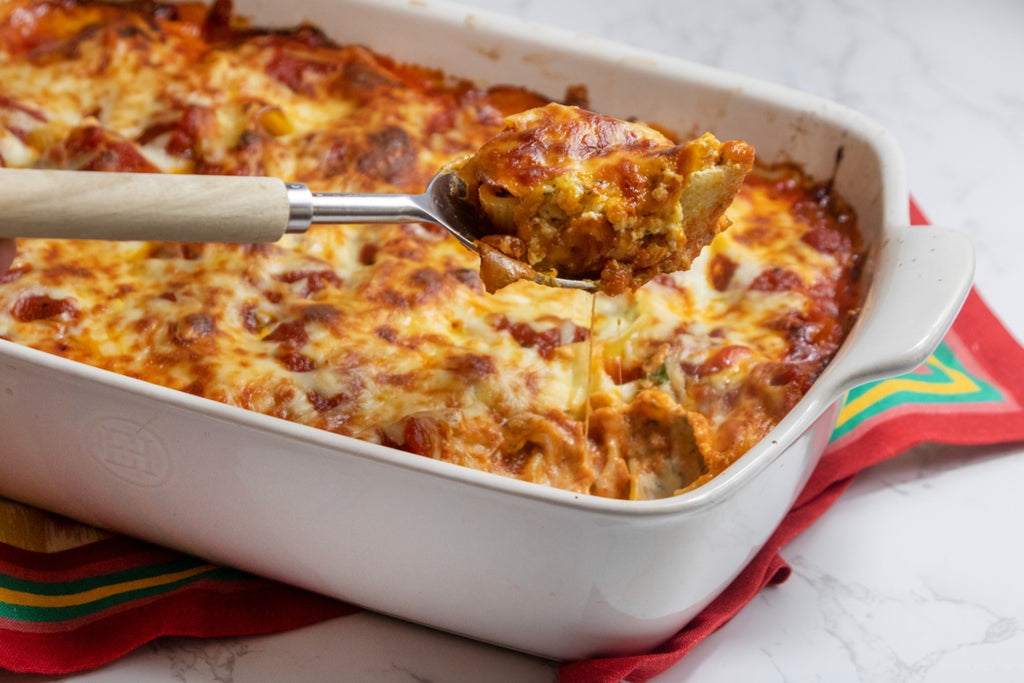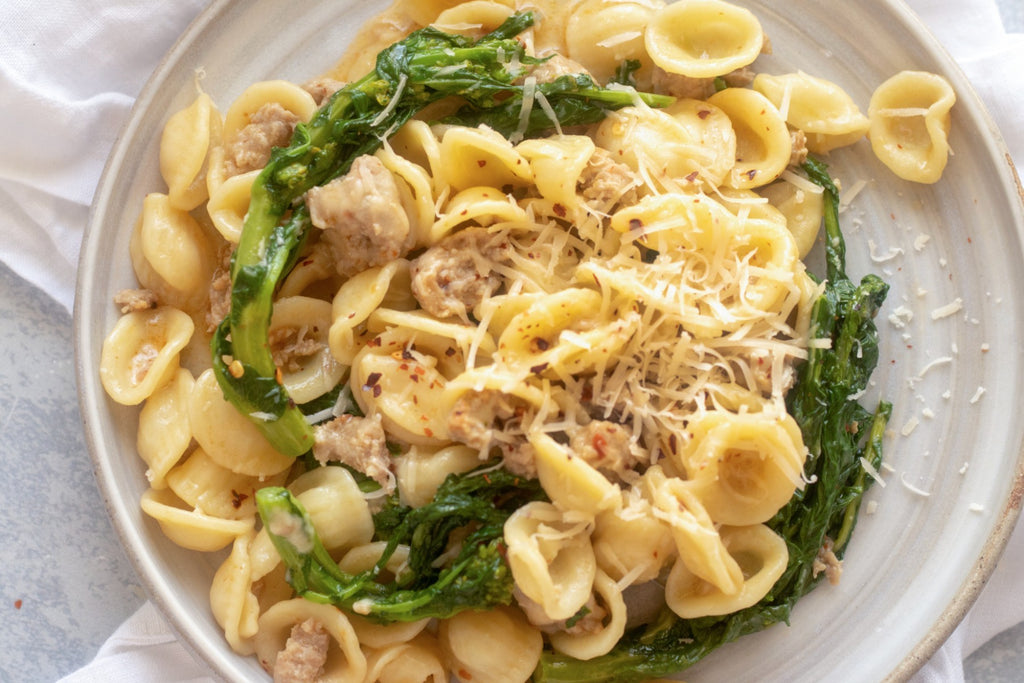Here's how to get your mouth around a pantry's-worth of Italian pasta names, and a few suggestions on how to serve it all.
If you're stuck in a pasta routine of bowl after bowl of plain old spaghetti, you're missing out. Although the flavor of pasta doesn't vary all that much, whether it's a short cut or long, the way that the shapes interact with the sauce has a big impact on the finished dish. And as a bonus, each has an Italian name that's fun to pronounce, and sometimes a little funny when translated.
There are literally hundreds of different cuts out there, but it's common to find the same dozen or so appear again and again. If you're looking to get even more variety, consider seeking out pasta made by an artisanal producer, who use heirloom grains, local flavors, seasonal specialties, and more exotic shapes.
Read the phonetic spellings below, then read on for the basics on some popular and more unusual shapes, along with a description of the sauces they pair best with.
Bucatini (boo-kah-TEEN-ee; "little holes") Hailing from Rome and the surrounding Lazio, these strands are like thick spaghetti with a small hole running from end to end. A versatile pasta, they're often served simply with a red sauce, or with butter or olive oil and a bit of grated Parmesan.
Capellini (ka-pull-EE-nee; "little hairs") Also known as angel-hair pasta, these long, thin noodles cook quickly and go best with light sauces that won't weigh them down. Think olive oil, garlic, and lemon, or a simple tomato-basil sauce.
Casarecce (ka-sa-RAY-cheh; "homemade") Narrow, rolled, and twisted tubes, this pasta is as rustic as its homey name suggests. Try it with chunky sauces or in casseroles.
Conchiglie (kohn-KEEL-yeh; "shells") These come in various sizes, from very large ones meant for stuffing, to very small ones, which are called conchigliette. Shells are good with meat sauces, and the small ones work in any dish where you'd use elbow macaroni.

Arrabiata Stuffed Conchiglie "Shells"
Croxetti (kro-KET-tee; "little crosses") Like coins of pasta, these disks are stamped with different patterns. They date back to the Middle Ages, when wealthy families had them adorned with their coats of arms—the ultimate edible status symbol. Serve with a simple, light sauce, or just a bit of olive oil.
Farfalle (far-FALL-eh; "butterflies") Often called bow tie pasta, these pretty butterfly shapes taste best with simple olive oil– or tomato-based sauces that may incorporate ingredients such as peppers, chicken, or arugula. They are also great for a pasta salad because the shape is fun and bite-size.
Pasta Primavera with Farfalle Pasta
Fettuccine (fet-too-CHEEN-eh; "little ribbons") Similar to linguine but thicker and wider, these noodles are suitable for many sauces, including those that are cream-based or made with meat.
Fregola Sarda (FREG-o-lah SAR-dahgola; "little Sardinian fragments") As the name suggests, these bead-like bits of pasta hail from Sardinia. Similar to Israeli couscous, they are thought to have come to the island with immigrants from the Genovese colony in Tunisia. A traditional fregola preparation includes tomato sauce and clams.
Fusilli bucati (foo-ZEE-lee boo-CAH-tee; from the Italian for "spun" and "hole") Similar to fusilli, which look like corkscrews, these noodles look more like bedsprings. They are a good choice for thick-and-hearty sauces because all the "goodness" gets trapped inside the spiral rather than just coating the exterior.
Gigli (GEE-lee; "lillies") Resembling a flower, with a bell-like shape and ruffled edges, this shape stands up best to thick sauces and the chunky ingredients of a casserole.
Girelle (gee-REL-eh; "swivels") This shape takes its name for its corkscrew-like turns. Try it with ingredients that can cling to its substantial curves, such as a pesto and vegetables.
Gramigna (gra-MEEN-ya; "weed") Small, grass-like curls of pasta, these noodles cling to most ingredients. They lend themselves to light sauces with a few small chunks of meat or sausage.
Linguine (lin-GWEE-neh; "little tongues") These long, flat strands are slightly curved in their cross section, like the tongues they are named after. They stand up to sturdier sauces, such as a pesto, tomato, or mushroom sauce, or those with flavorful ingredients, such as shellfish. Linguine with Sun Dried Tomatoes, Olives and Lemon
Linguine with Sun Dried Tomatoes, Olives and Lemon
Macraoni (mak-a-ROW-neh) Most commonly used in the United States in macaroni and cheese or pasta salads, these curved tubes make an ideal ingredient for soups and stews, such as pasta e fagioli.
Mafalda (ma-FAL-da; named after Princess Mafalda of Savoy) These flat, wide, ribbon-like noodles have wavy ridges that make them look a little like narrow strips of lasagna. They go best with light, delicate sauces that cling to their smooth sides.
Orecchiette (or-ay-KYET-tay; "little ears") Resembling their namesake ears, these round, curved pieces hail Southern Italy, and they are often served with broccoli rabe and sausage.

Orecchiette with Sausage and Broccoli Rabe
Paccheri (pa-KER-ee; "open-handed slap") These short, wide tubes where said to have been invented during the Renaissance for use in smuggling garlic across the Alps into what is now Austria. This variety is suited to thick sauces, which cause them to make a slapping sound when eaten.
Penne (PEN-eh; "quills") These small tubes may be smooth or ridged (rigate). Penne is best used in soups, pasta salads, and with thicker sauces and casseroles because the ingredients and sauces can penetrate the inside of the pasta. Penne rigate is ideal for meat, vegetable, or butter-and-oil-based sauces because the ridges hold the sauce.
Riccioli (REE-key-oh-leeiccioli; "little curls") Short, wide, and with a twist, these pieces stand up to chunkier ingredients like meat and cheese.
Rigatoni (ree-gah-TOE-nee; "ridged") This wide, ridged, tube-shaped pasta has holes on either end that are large enough to capture pieces of vegetables in a sauce. In addition, this kind of pasta is perfect for baked dishes made with sauce and cheese.

Rigatoni with Pork Ragout
Strozzapreti (strote-za-PRAY-tee; "priest chokers") There are a few legends about how this short, rolled pasta got its colorful name. One says that Roman housewives who made it would "choke" the dough with such force, it looked as if they could choke a priest. Serve it as you would penne, with meat, vegetables, or just butter and oil.
Tagliatelle (tall-yuh-TELL-eh; from the Italian tagliere, "to cut") A ribbon that's generally narrower than fettuccine, this versatile pasta lends itself to various sauces, but is traditionally served with Bolognese or other meaty sauces.
Trofie (TROH-fee) This short, tapered, twisted pasta from Genoa pairs well with pesto and other simple sauces.















0 comments